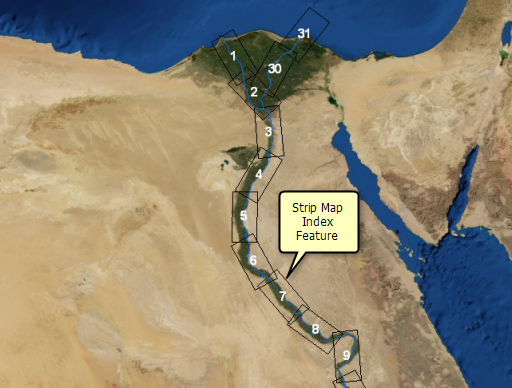A spatial map series is a collection of pages built from a single layout in which the map frame on each page shows a different map extent. The map series is built by iterating through all the features in a layer, called the index layer, creating a page for each feature. The map extent for each page is a feature. For example, a spatial map series can contain an individual page for each parcel in a neighborhood. Once created, the series can be exported as a single .pdf file, or files can be created for each page.
A spatial map series can contain both dynamic and static elements. The static elements on the layout remain constant for each page in the map series. The dynamic elements, such as the map frame in the series, update for each page. Other dynamic elements can include text, table frames, legends, and pictures. For more information on how to use dynamic elements in a spatial map series, see Spatial map series and dynamic elements.
For all spatial map series, the map extent is taken from the features in the index layer. The map remains the same for each page, but the extent changes. Optionally, you can use fields in the index layer to change the map rotation and the spatial reference for each map series page.
The following video shows how to make a spatial map series.
- Video length: 1:30
- This video was created with ArcGIS Pro 3.2.
Spatial map series examples
There are many reasons to create a spatial map series. Often, an existing layer works well as an index layer, such as parcels, states, countries, or national parks. Sometimes, you need to generate an index layer to show detailed sections of a larger area on a page. Two common cases for this are a grid index map series and a strip map series. The Map Series toolset provides tools to generate these index layers.
Grid index map series
For detailed maps representing large areas, you can break the area up into smaller map extents and create a layout for each smaller extent. A grid can divide the larger extent so the area is covered without overlapping. You can then use the grid as the index feature for the map series. The Grid Index Features tool can be used to automatically generate a grid over a given area.

Strip map series
A set of map pages that follow a line feature—such as a river, road, or pipeline—is called a strip map series. Each page of the map series shows a defined geographic area on either side of the line feature with subsequent pages showing areas farther along the line. Often, there is some geographic overlap between adjacent map pages. The Strip Map Index Features tool automatically generates a strip map grid over a given linear feature.

